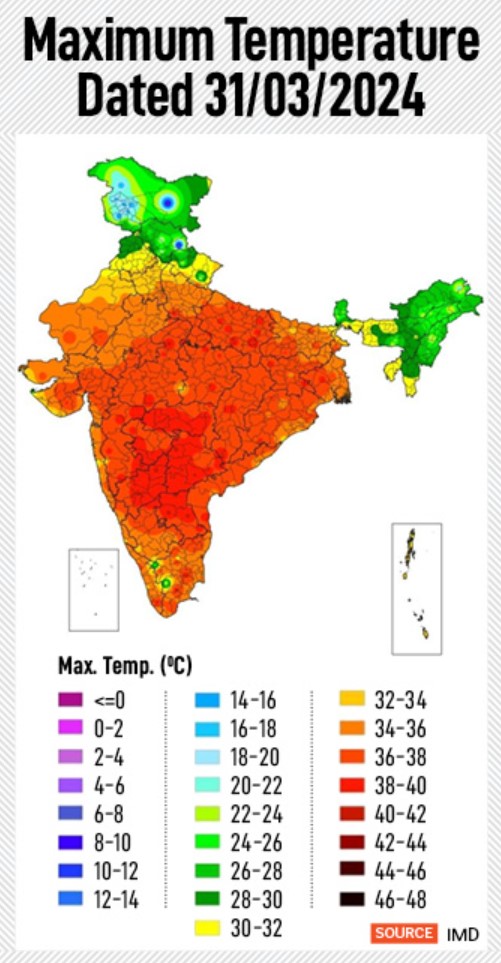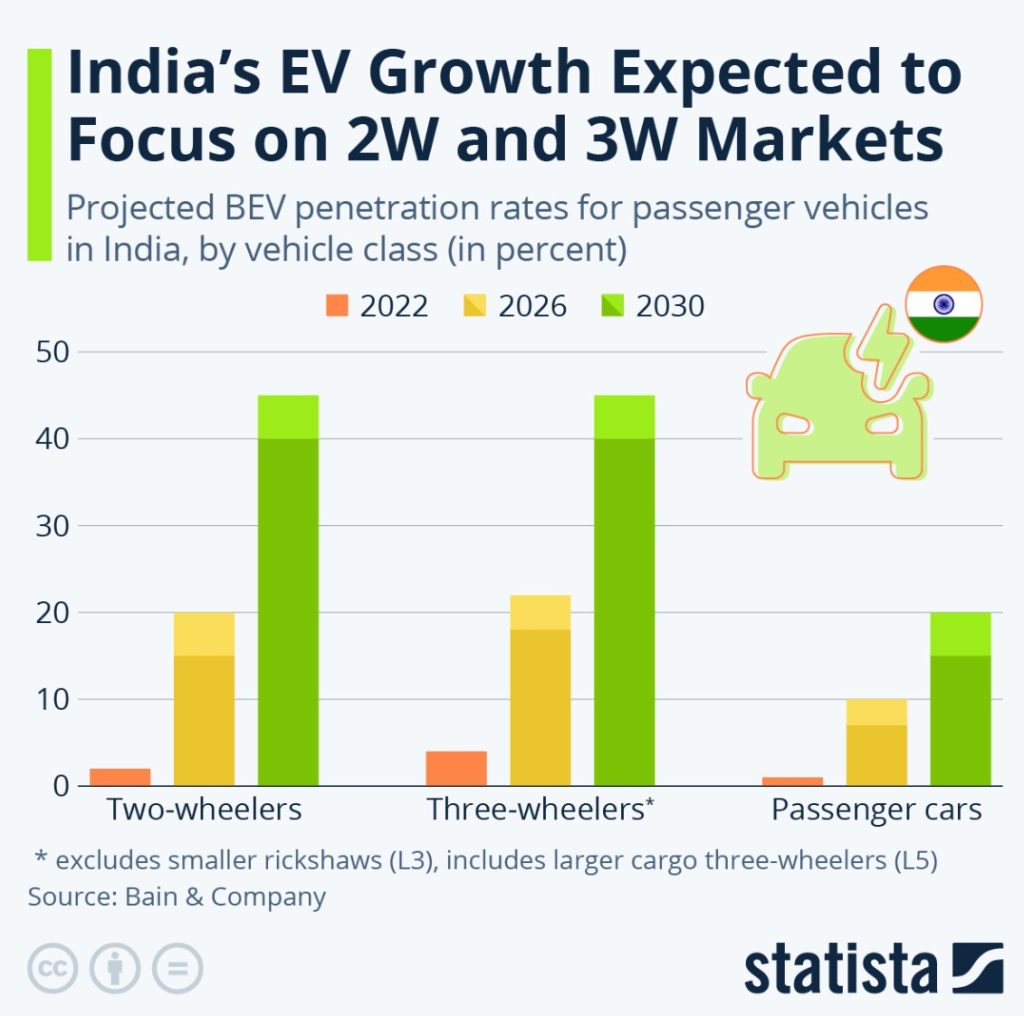CONTENTS
- Are Heatwaves Natural Disasters?
- Empowering India’s Electronic Vehicle Sector
Are Heatwaves Natural Disasters?
Context:
North India has currently experienced the longest heatwave in the past 15 years. According to data from the Ministry of Health and Family Welfare, at least 100 people have died from heat-related illnesses between March 1 and June 18 across India, although this number is likely underreported. The significant death toll has reignited the debate about classifying heatwaves as natural disasters.
Relevance:
GS3- Disaster Management
Mains Question:
Indian states have appealed to the Finance Commission to expand the scope of natural calamities eligible for disaster funds to include heatwaves. In this context, discuss the rationale behind classification of heatwaves as natural disasters and scrutinise the mechanisms in place to deal with heatwaves. (15 Marks, 250 Words).
Responding to Natural Disasters:
- The National Disaster Management Act (NDMA) is the principal legislation that outlines the responsibilities of the central and state governments in responding to natural disasters. The Ministry of Home Affairs oversees the implementation of this act.
- Various disaster management authorities derive their powers from this legislation, which also specifies the natural calamities eligible for state-backed compensation.
- Additionally, the NDMA has established special funds at both the state and central levels for disaster response.
- Currently, the Guidelines on Constitution and Administration of the State Disaster Response Fund (SDRF) and National Disaster Response Fund (NDRF) recognize 12 types of disasters: cyclone, drought, earthquake, fire, flood, tsunami, hailstorm, landslide, avalanche, cloudburst, pest attack, frost, and cold waves.
Inclusion of Heatwaves:

- Heatwaves are not included, a decision influenced by a government body not affiliated with the NDMA.
- States have appealed to the Finance Commission to expand the scope of natural calamities eligible for disaster funds to include heatwaves.
- The 15th Finance Commission, the constitutional body responsible for deciding the revenue sharing between the Centre and States, had noted in its report that the current list of notified disasters eligible for funding from the SDRF and NDRF largely meets the needs of the States.
- As a result, it did not support expanding the list. States have appealed to the Finance Commission to include more natural calamities, such as heatwaves, in the list to become eligible for additional funds.
- According to the existing guidelines, a State Government can allocate up to 10% of the annual SDRF funds, under certain conditions, for immediate relief to victims of natural disasters that are not among the 12 listed but are considered disasters in the local context.
- Consequently, compensation for heatwave victims, as confirmed by State authorities, is drawn from this allocation. The 16th Finance Commission, led by economist Arvind Panagariya, may review new requests from States.
Are Heatwave Deaths Rising in India?
- According to the National Crime Records Bureau, heatwave-related deaths in India have decreased from 1,127 in 2017 to 374 in 2021, with these deaths classified as ‘accidental.’ In 2022, 33 deaths were reported, none in 2023, and at least 100 confirmed this year.
- Despite fewer deaths compared to the 1,100 deaths in Andhra Pradesh in 2016, longer heatwave spells are becoming more frequent. State health departments are responsible for providing information to the Centre on heatwave-related illnesses and deaths.
- Classifying heatwave deaths is challenging as they often occur due to the combined impact of high temperatures and pre-existing conditions like cardiovascular disease or hypertension.
- Additionally, definitions of a heatwave vary. While temperatures above 45 degrees Celsius are typically considered heatwave conditions, it can also mean temperatures 4.5 degrees or more above normal for a location.
- For example, Himalayan States reporting mid-30s temperatures may consider these heatwaves as they are significantly above normal, though no official heat-related deaths have been reported in these areas.
- Andhra Pradesh, Odisha, Telangana, Gujarat, and Rajasthan usually report the most casualties from heat each year.
- Although there are medical guidelines to help doctors confirm or rule out heatwave illnesses, their application is often inconsistent.
Conclusion:
It is important to recognize that heatwaves are complex phenomena influenced by multiple factors. Their occurrence and intensity can vary between regions due to the interplay of these contributing elements. With the increasing frequency of heatwaves, State, district, and city authorities have developed heat action plans (HAPs). The NDMA and the India Meteorological Department are collaborating with 23 States to create HAPs, which provide a snapshot of a region’s heat profile, including past heatwave events, trends in summer maximum temperatures, land surface temperatures, and vulnerability assessments. These assessments identify regions needing immediate attention and outline a response plan.
Empowering India’s Electronic Vehicle Sector
Context:
The adoption of electric vehicles (EVs) in India is still in its early stages. Research from S&P Global Ratings indicates that the EV penetration rate in India was only 1.1% in 2022, compared to the Asian average of 17.3%. The EV ecosystem needs additional support in its early stages, and the government has a vital role to play.
Relevance:
GS2- Government Policies & Interventions
GS3-
- Achievements of Indians in Science & Technology
- Mobilization of Resources
Mains Question:
Why does India need to accelerate its EV adoption? What are the challenges in this regard and what can be done to overcome them? (15 Marks, 250 Words).
Rationale for Accelerating EV Adoption:
- Transport emissions in Indian cities are rapidly increasing, with road transport accounting for about 87% of the total emissions.
- Coupled with the aggressive shift towards renewable power generation, EVs can substantially reduce transport-related pollution at both local and national levels.
- Additionally, transportation is the third-largest energy consumer and the largest consumer of oil fuels, responsible for 70% of diesel and 99.6% of petrol consumption.
- With India importing about 80% of its oil, and crude oil prices being highly susceptible to global geopolitical tensions, decarbonizing transportation can mitigate risks to the country’s energy security.
The EV Market in India:

- The Indian EV market is experiencing swift expansion, with EV sales increasing by more than 45% in 2024 despite regulatory changes.
- Total EV registrations exceeded 1.5 million units by the end of 2023, a notable rise from just over 1 million the previous year.
- This growth in registrations has boosted India’s overall EV market penetration to 6.3%, showing considerable progress in EV adoption.
- Indian automakers are making significant investments in electrification, motivated by the government’s plan to gradually phase out subsidies.
Challenges for EVs:
High Initial Cost:
- The upfront cost of purchasing an electric vehicle is higher compared to conventional vehicles, making them less affordable for many potential buyers and limiting the demand for EVs.
- This cost disparity is mainly due to the expensive battery technology used in EVs.
Limited Charging Infrastructure:
- In India, charging infrastructure is still in its early development stages and is mostly concentrated in major cities.
- The lack of a widespread and robust charging network makes it inconvenient for EV owners, especially those living in apartments or without dedicated parking spaces.
Range Anxiety:
- Range anxiety, the fear of running out of battery charge while driving, is a significant challenge for EV adoption.
- Despite improvements in EV ranges, there is still a perception that EVs may not provide sufficient range for long-distance travel, particularly in a country with vast distances like India.
- Additionally, EV batteries degrade over time, which can reduce their range.
Battery Technology and Supply Chain:
- Producing lithium-ion batteries, a key component of EVs, requires specific minerals and rare earth elements.
- India currently relies heavily on imports for battery manufacturing, leading to supply chain challenges.
- Moreover, the charging time for EVs is longer than the refueling time for conventional vehicles, affecting their convenience and usability.
Limited Model Options:
- The availability of electric vehicle models in India is relatively limited compared to conventional vehicles.
- The market needs more options across various segments, including affordable EVs, to cater to diverse consumer preferences and requirements.
Way Forward:
Role of Governments in this Regard:
- Governments play a crucial role in promoting the mainstream adoption of EV technology in the motor vehicle sector.
- Over time, the competitiveness of new technologies compared to existing ones increases due to established supply chains, economies of scale, consumer preference, and improved performance and maturity.
- However, relying solely on market forces to transition from internal combustion engine (ICE) vehicles to EVs is unrealistic.
Localizing Production:
- Electrification also offers India a chance to enhance its position in the global automotive value chain.
- By localizing production for domestic EV consumption and developing cost-effective solutions in niche areas for outsourcing, India can strategically develop its EV sector and seize this unique opportunity.
- The Indian government has supported transport electrification through several initiatives, including the Faster Adoption and Manufacturing of (Hybrid &) Electric Vehicles (FAME) schemes (I and II) , reducing the Goods and Services Tax (GST) on EVs to 5%, and offering an income tax exemption of up to INR 150,000 on interest payments for EV loans.
- Additionally, the new Electric Mobility Promotion Scheme 2024, with a budget of Rs 500 crore, provides subsidies for adopting and manufacturing e-2-wheelers and e-3-wheelers.
- Further support includes various guidelines and notifications on EV charging standards, delicensing EV charging services, capping EV tariffs for charging infrastructure, model Development Control Regulations (DCR) and building codes for EV charging, and green license plates for EVs.
- The early success of e-mobility in India is largely due to a supportive policy environment at both the national and state levels.
- Out of 36 states and Union Territories, 26 have released EV policies in the last five years, with 16 of them being released between 2020 and 2022.
Here are seven policy recommendations and subsidies needed in the EV MSME sector:
- Reduced Taxation & Duties: To make EV manufacturing more competitive, it’s crucial to implement tax breaks or reduced import duties on raw materials, components, and EV-specific parts imported by MSMEs.
- Infrastructure Development Support: Provide subsidies or tax incentives to MSMEs involved in setting up EV charging infrastructure. This could encourage more investment in charging stations, particularly in remote or underserved areas.
- Production-Linked Incentives: Introduce production-linked incentives (PLI) for EV MSMEs. These incentives could be based on achieving specific production milestones, thereby encouraging scale and efficiency.
- Promote Research and Development: Encourage MSMEs in the EV sector to engage in research and development by offering grants, subsidies, or tax incentives for innovative projects and technologies aimed at improving EV components, systems, and manufacturing processes.
- Facilitate Access to Finance: Establish dedicated funds or financial institutions to provide low-interest loans, venture capital, or grants specifically tailored for EV MSMEs to invest in infrastructure, technology adoption, and capacity expansion.
- Export Promotion: Offer incentives and support programs to help EV MSMEs tap into international markets. This could include assistance with export promotion, market research, participation in trade fairs, and overcoming trade barriers.
- Collaborative Initiatives with OEMs: Encourage partnerships and collaborations between EV MSMEs and established Original Equipment Manufacturers (OEMs). Provide incentives for OEMs to source components from MSMEs.
Conclusion:
Decisive and urgent action is necessary to achieve the target of 30% electric vehicles by 2030 in India. Formulating and notifying an EV policy is just one piece of a larger puzzle.



